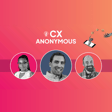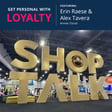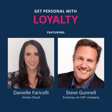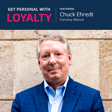Become a Creator today!Start creating today - Share your story with the world!
Start for free
00:00:00
00:00:01

The Stakeholder Game: Managing Alignment
The Loyalty Lounge Powered by Annex Cloud Presents CX Anonymous: The Stakeholder Game: Managing Alignment. Loyalty and customer experience is not a set-it-and-forget-it initiative. Emily Grill, marketing and digital strategist, brings insight into how to align and realign in projects, misalignment symptoms, and her favorite ways to bring everyone along.
Transcript
Introduction to CX Anonymous
00:00:04
Speaker
Welcome back to CX Anonymous, the series where we provide tactical advice on successfully executing customer experience. We don't care who you work for, just how it got done. On this series of CX Anonymous, we're continuing the discussion of the stakeholder game. We all have to play it to get our initiatives out the door.
Guest Introduction: Emily Grill
00:00:22
Speaker
I'm your host, Amber Collins, Product Marketing Manager at Annex Cloud, the Scott Sherson,
00:00:29
Speaker
Product Solutions Director, and our guest today is Emily Grill, Marketing and Digital Strategy Professional. So thanks so much for joining us. Please tell us a little bit about yourself, Emily.
Emily's Experience in Stakeholder Management
00:00:40
Speaker
Awesome. Thank you for having me. A little bit about my background. I started in Merchandising and headed over to Consulting for retention. So I have a lot of previous experience working with several different stakeholders in the game and trying to get a project out the door.
00:00:58
Speaker
So I'm really excited. Absolutely. We're so excited to have you. So of course, the season's ongoing topic, managing stakeholders has focused on quite a few aspects, but the biggest common theme that I think we've seen here is alignment. And just like a car, you get your alignment when you pull it off the lot, but you get down the road far enough and you're going to need to pull over and get another alignment.
00:01:20
Speaker
So Emily, I would love to hear from you. How do we get and stay aligned in a project for customer experience stakeholders, which we know is highly cross-functional, it's highly impactful, it's highly visible. So how do we get and stay aligned?
00:01:39
Speaker
Yeah, definitely. So I think this is, to me, the most important thing when you are kicking off a project is making sure all the right key stakeholders are in the room from the get-go. You need their buy-in to continue along with the project. So without having the right people in the room from the start, there's gonna be a lot of questions and the game of what is the objective? What are we trying to accomplish along the way that are gonna be harder, a harder hurdle to get over?
00:02:07
Speaker
I think the most important thing is starting with that kickoff session with all key stakeholders. That might be everybody from an analyst
Kickoff Sessions and Stakeholder Buy-in
00:02:17
Speaker
level role that is doing day-to-day execution all the way up to your C-suite, just to make sure everybody in the room is aligned on what is a project goals, what are the project objectives. At the end of the day, you have that to go back to and center around so that you're not driving off course, as you mentioned, Amber.
00:02:37
Speaker
So just to clarify that a little bit, when you're saying the start of a project, because obviously, we work as a product, which is a part of the overall project. You're talking about specifically the project from its initial genesis. We want to do a thing, not when we're starting to bring in third parties or outside consultants. You're talking about, I have an idea.
00:02:59
Speaker
bring everybody together, right? Yeah, that's a great clarification, Scott. And I think, yes, it's from the from the get go, like, we want to launch a loyalty program, who are the key stakeholders you need to get involved, so that everybody knows to your point, like, you know, we want to try to outsource this part or
00:03:17
Speaker
It's going to take these internal resources to do the next part.
Involving Relevant Stakeholders Effectively
00:03:21
Speaker
So it's really important to get everybody on board from the beginning so that they feel like they have that seat at the table to speak about their experience or, you know, any risks that they see versus bringing them in later on. Then it's really hard to get people on board and to move forward. Are there any tips and tricks that you recommend for finding those like undercover or hidden stakeholders, you know, people that
00:03:46
Speaker
You don't think about it automatically. What do you do to help align people with those? Yeah, the way I always think about it is like, how is this specific task or action going to impact the company? So it's less about you and how it's going to impact your role.
00:04:02
Speaker
if we decide to bring in a third party as an example, how will that impact the team that I might work on? How will it impact our technology team? How will that impact finance? If you think about it from that perspective, that allows you to think through, we forgot Susan and we need to bring Susan into the conversation to make sure that she's on board. Yeah, if you think about it that way. Let's say you forgot about Susan, like everybody.
00:04:31
Speaker
It happens, right? So Susan gets brought in a month later. Sorry, Susan. We love you. You brought Susan in. Now she's got a different perspective because she wasn't a part of that original alignment. Is it more about getting Susan on board or is it about the realignment to the overall project? What's the better approach?
00:04:51
Speaker
I would say both. What I personally like to do, and I know everyone has a different working style, but from my experience, I like to kind of pull Susan off to the side first to have like a pre-meeting with her and say, hey Susan, we've started this project. As we were going through it, we realized you're really a key stakeholder in this.
00:05:11
Speaker
and this is what we need from you, what are your concerns with what we've done already so that we can better prepped for that conversation with the rest of the key stakeholders to get that if needed realignment or just alignment from Susan. It's really helpful to bring them in separately first so that they feel like their voice is going to be heard in the session and it doesn't come across as defensive, which it can quite easily and I've been hearing this happen.
00:05:39
Speaker
It can become defensive if they feel like, you know, like, well, my voice wasn't heard. Well, I didn't get to see this beforehand. So it's better for a pre-conversation. Yes. I think that it's kind of knowing the answer before you put them all in the room because you've done that
Identifying Misalignment in Projects
00:05:56
Speaker
pre-work. And we've spoke about that on previous episodes. But really, you think that you've done this work. You think that you've got this, you think that you've looked at your risks.
00:06:05
Speaker
Emily, what are some of the signs that you still don't have alignment? How do teams act to respond? We spoke about defensiveness just now. How do teams respond if they're out of alignment? What are those signs? Yeah.
00:06:18
Speaker
I would say based on my experience, it's people just being quiet in meetings and kind of just going with the flow when they normally wouldn't. And when I say when they normally wouldn't, it's usually they come with questions, come prepared, but they almost seem disengaged from the project.
00:06:37
Speaker
That's kind of a, I guess, more visual sign to me. The more non-visual is, you know, you're following up on emails, you're asking for advice, and they're just not responding. That, I mean, it happens, and people, you know, people might get busy, so that's a good time to check in with them, too, just to say, hey, I sent this over, really want your advice. You haven't had a chance to look at it yet.
00:07:00
Speaker
maybe they're busy inside or outside of work, or maybe at that point, to your point, Amber, maybe they've become disengaged or disaligned, and that's your time to go back to them and say, what can we do to make sure that you're an advocate for this project? Absolutely. Scott.
00:07:17
Speaker
When you are creating tech validations and giving demos, what are some of the signs that you see in stakeholders across the table that it might not be resonating or it's not hitting the mark for them or they just are going to become possibly a detractor in this process? Well, the first sign as Emily mentioned is just silence. We had one customer that said, if we're shouting, we're engaged. We love it. So the people who are just like absolutely silent
00:07:47
Speaker
chances are they're either disengaged, as Emily mentioned, or they're, you know, second screening, they're doing something else and they're just not interested in it. When somebody's presenting, let's say, you know, like Emily's presenting and I'm on deck, I'm watching cameras, I'm, you know, checking chats and stuff like that so that I can text Emily on the side to say, hey, you know, speed this up, slow this down, you know, because so-and-so is whatever. And then I hope that, you know, she would be doing that for me as well because,
00:08:15
Speaker
When you're presenting, you're typically trying to present and drive things at the same time. Like when, I'm assuming when Emily does like her thing, she's got, you know, whiteboards and she's got like markers and she's, you know, aligning, creating mission statements, you know, all of these things. And Emily, you can talk about your tools all you want, but you know, the person driving can't be watching as well. Yeah. Yeah.
00:08:40
Speaker
And that's a great point, Scott, too. Not only having pre-meetings with people who have brought in late to the project, but let's say Scott and I are really leading this project together, him and I having alignment so that he's that advocate in the room for me is so important. And I've seen that time and time again, especially when I was consulting back in the day, we'd have those pre-meetings with our main point of contact for the company we were working with.
00:09:06
Speaker
so that they were our advocate in the room for the company with us as consultants because sometimes consultants get a bad rap and people don't want to listen to them. But as long as you have that advocate in the room from the company that you're working with, it makes the conversation so much smoother and so much easier to have.
Risks of Stakeholder Misalignment
00:09:26
Speaker
Let's talk a little bit about those risks.
00:09:28
Speaker
if we've got disengaged stakeholders, if we've got people that we're struggling to get a response for. I'd like to talk about the risk to the customer experience team, and then we can talk about the risks that it goes into once you bring in a third party vendor like Annex Cloud, right? Yeah, yeah.
00:09:48
Speaker
I mean, the number one risk I can think of is time. So everybody's always on a timeline. They want to get the project done as fast and as quickly as possible. And the biggest risk is you are going to elongate the project without having those key stakeholders aligned either from the beginning or making sure that you have those check-ins along the way because people are going to want to go back to a conversation you had two months ago.
00:10:13
Speaker
So making sure everyone's aligned at every single checkpoint is just going to make that timeline what you want it to be. I would add to that only slightly to say that misalignment can sometimes kill a project. So that timeline becomes infinite because we didn't bring in Susan and so now Susan's the head of IT and she wants to do a whole validation of this thing and time and now we've spent that budget somewhere else and now this project is dead for this year or the next two years.
00:10:43
Speaker
time can just be like a short two week, three week hiccup or it can be just death to a project.
00:10:49
Speaker
Yeah, I mean, I think on our side as the vendor by the time, if you've got misalignment in your team, or you've got disengaged stakeholders, obviously, you know, time, we know that it takes time to evaluate and choose a enterprise level software. But there's a risk here that say you've been able to close that deal, say you've been able to get your team to agree to the technology,
00:11:13
Speaker
If you've had misalignment, there's a huge risk here that you've chosen the wrong technology. There's a huge risk here that you have things that are unforeseen that had you had that alignment, maybe the other person wouldn't have assumed that you had thought about this or assumed that this was taken care of. Then you get into something where you've got a contract signed and you've got multiple people's eyes on this project and you have to what? Turn around and say, oops, my bad. Emily, what happens then? What do you do?
00:11:43
Speaker
Yeah. You know, luckily, I think if you do all the right prep, you're not going to get to that worst case scenario of having contract and we can't move forward.
00:11:54
Speaker
you know, it might happen. There's always that chance. I have personally never experienced that aggressive or that type of scenario. But I have, I mean, I've definitely gotten to the point where, I mean, people almost, and I'm just going to say, they feel butt hurt, that they weren't brought in to the conversation or the selection process of
00:12:14
Speaker
a third-party vendor. And in those scenarios, it's just reiterating what their value to the businesses and to the project, as well as what their role is. Because they might be two different things. So in those cases, too, it's always nice not having just you voicing that opinion. It might be
00:12:37
Speaker
your co-owner of the project, it might be your boss, just letting those people know like, hey, this is where we really need you in the project and this is why you might not have been involved in that selection process. It's not always the easiest conversation to have, but I think at the end of the day, if people know what's right for business, they understand where and when they were brought in. Then let me ask you because I'm in IT, I'm very binary and I
00:13:06
Speaker
I just want to point at an email. I want to point at a thing and say, no, this was what we aligned on. This is, but you're the professional. So how can people more softly do that? How can I bring Susan away to thinking of the project in a way that she feels empowered without having to like,
00:13:23
Speaker
just like point at stuff and say, deal with it. Yeah, whistle blow or raise a flag on her, you know, cause that doesn't really, in the end, you still have to work together, right? Yes. Yeah. I think, you know, again, based on my experience, it's trying to show Susan or whomever, you know, their, their value.
00:13:41
Speaker
in the project and in the business. It's at the end of the day, it's always coming back to how is the business gonna, how are we gonna help the business grow? And how is this project gonna help us get there? And then if you can align on that with Susan, then it's like, okay, Susan, what is your part in that versus what is Emily's part versus what is Amber's part? And helping her see the bigger picture.
00:14:05
Speaker
helps, I think, with that conversation because then they're not thinking about me and why I wasn't brought in and why I wasn't part of the conversation. They're thinking about, you know, what's the best for company and what's the best for our business growth?
00:14:21
Speaker
So then let's talk about how does Susan and Emily and Amber start acting when they are in alignment? What are the signs that you've got alignment and consensus and that you've got the buy-in and how do teams behave when that happens?
00:14:37
Speaker
Yeah, I mean, I feel like conversations just come easier. People are more engaged in conversation. So those are some of the visual signs. I would say is, you know, they want to add their input. They might be coming to you off to the side with additional ideas about how to make the project even better from conversations that you guys have had. And then it's also just being your advocate. So anything that you're
00:15:04
Speaker
presenting whether it's internal or external to the third party, that person is, I'm aligned, I'm on board with everything Emily has said. I love that. I think that that builds deeper relationships that then when the next project comes along, you've got past performance,
00:15:23
Speaker
and pass dynamics to work on and it just creates this snowball effect of a little power team. I think that first time is really always hard. I want to know because this is obviously, we do all this for the customer.
00:15:36
Speaker
We do all this to create this frontline experience that helps customers fall in love with us, helps customers fall in love with the brand, the experience, the product, etc. I don't want to call out brands specifically, but I think we all know brands that have put out things that screen misalignment, did the left-hand talk to the right hand and things like that. But let's just talk for a second about
00:16:04
Speaker
the importance of this alignment that goes from behind the scenes to out into the marketplace. And how does it affect customer experience and building that loyalty?
Impact of Alignment on Customer Experience
00:16:15
Speaker
Yeah, I mean, I think that's a really great point. You can tell right off the bat and again, not naming names, but companies that obviously didn't have that all internal alignment, it's going to impact your customer engagement. So if we're talking about loyalty and loyalty in a program, if you don't have alignment in house, your customers aren't going to engage with your program and your program's not going to grow. So you'll be able to see in the data internally on the internal side, you know, that
00:16:45
Speaker
the program isn't working because of the misalignment that you had. Luckily, I would say in most cases, the customer is not going to know. They're not going to see us as loyalty experts might know, but they're not going to notice a difference. They're just going to decide, you know what, this program isn't right for me, and I'm just going to go to the next place to get the program that I want. So they might also jump ship from your brand.
00:17:15
Speaker
Scott, how do you feel like this internal misalignment or teams that have amazing alignment impact that external stakeholder, which is our customer? Well, what I've experienced specifically with loyalty is the misalignment with specific groups like a customer service team is you're standing there in store, you're making that call and you're asking about it and they're like, oh, don't worry about that. Or maybe they're just going to like beep their own code just to get you through.
00:17:43
Speaker
There's no alignment on the benefit to the member, so they're not brought along. The customer service team is not brought along, so they're not touting the benefits. There's no WIFM for them, so there's no reason to talk it up. So the misalignment there, as Emily was saying, creates a disjointed member experience. I'm walking in and either I'm being told, this program is crap, it's too hard for us to understand. Yeah, I agree with you that the program
00:18:12
Speaker
stinks, so I'm sorry for that here. This other code that I know will work and get you some discount or whatever, and then you just, because they're trying to make that experience a positive experience no matter what, right? So how are they doing it, and how is that disstranded from the overall program and ideal? So this kind of goes back to what we were saying at the beginning, is the alignment of everybody along that chain in order to make that customer experience at every touch point,
00:18:40
Speaker
Yeah, and you know what? When people think about Omni Channel, I think that sometimes it's missed having loyalty be Omni Channel as well and empowering those customer facing teams that are creating that experience and not just relegating your loyalty to your app.
00:18:57
Speaker
and not just tucking it away in the corner of your e-comm and not just having your shopper card that is never connected to anything else when you go to the grocery store. That connection there, that alignment, that digital alignment across your tech stack, across all those tech stores, I think people sometimes forget that loyalty is included in that.
00:19:15
Speaker
and that if you've got it relegated to this one space of your customer journey, it is not reaching its full potential. We know how hard it is to integrate anything in email, text, all of that stuff. Loyalty has to be a part of those conversations when you think about that omni-channel experience. Scott, you're 100 percent right. I feel like sometimes it does get a little forgotten about that.
00:19:39
Speaker
you may want to use your points when you go to the customer service desk in the store that you earned when you did the online order from the mobile app. Yeah, I completely agree. It's a great point to bring up customer experience and customer service because if they're not your number one advocate, it's going to be your customer at the end of the day. That word of mouth is so important. The first line of defense is always,
00:20:04
Speaker
the people who are boots on the ground and the people who are customer service representatives.
Effects of Internal Misalignment
00:20:10
Speaker
As Scott mentioned, if they're just like, the program isn't that great, let me just give you this other code, you're not going to see the engagement you want in the program. You really need to help train those customer service representatives to help them understand what is the value of the program and what is the benefit that the member is getting. I've seen this time and time again where
00:20:30
Speaker
customers that I've worked with have not thought it's that important, and then realize later on that it is, or ones that have trained their customer service from the get-go and their program has grown exponentially faster. I would add on top of that, but because Amber and I are focused on loading, but this extends to other projects as well. You bring on a new ERP, you bring on a new product warehousing software or something like that, and if it's not aligned with everybody, then again, your frontline person,
00:21:00
Speaker
is standing there with a customer saying, the online shop says that you had three of these in stock. I want one of them. And you're like, warehousing is wrong. And they're telling the customer that they don't have that. And they just made this trek maybe even across town to get something. So alignment isn't just a loyalty thing. It is alignment, the same groups across the board. And like you said, building on that relationship for everybody and understanding how everybody's interconnected
00:21:29
Speaker
builds a community within that where we can think about everybody and think about the organization as a whole because everything matters to the customer at the end of the day.
Summary and Key Takeaways
00:21:42
Speaker
Yeah, I absolutely agree. Again, with a lot of these conversations, I mean, we could talk all day. This is definitely a passion of this group. And, you know, I think that we have all experienced this not only as professionals, but also as consumers. And so let's wrap up today's episode with a couple of takeaways.
00:22:01
Speaker
and i really want to call out that you know i sort of wrote down sort of right people right impact right value and getting that alignment is going to have those right people in the room helping them understand that that right impact to themselves and the customer to provide that right value that aligns up with those organizational goals and as we just talked about i mean that comes from
00:22:23
Speaker
getting insights from merchandising and CS and warehousing all the way up to that pie in the sky aspirational strategy that our leadership wants us to get on board with. And so that was something that for me, you know, we could say it all day, we say it all the time, but in practice, sometimes it's really hard.
00:22:40
Speaker
but i think that that thinking about it is sort of like a framework of what's in it for them what's in it for the company is a great way to make sure that you've got all those important very important voices in the room and so i also wanted to call out some of the signs of misalignment i think that again this is something that we've all experienced before you've got somebody who is
00:22:58
Speaker
disengaged who is normally opinionated and they're very quiet and it doesn't mean that they don't have an opinion it just means that they might not be comfortable sharing it with you in this setting or with this project or they felt disenfranchised or they felt slighted because why didn't I come in five weeks ago so just to look for the signs of that misalignment
00:23:17
Speaker
and to really get back on track, get your car in the shop, get it realigned, get it checked out with whoever you need to get that part looked at because you have to get things done. Otherwise, projects like this, projects like loyalty die on the vine. Those are some of the biggest things that I took away from our discussion today. Scott, what do you think? I think one of the first points that we made is about when to do the alignment. It's not when you're starting to think about third parties or consultants to come in the room,
00:23:46
Speaker
It's the moment you have an idea, get everybody to align on that idea so that you're not going off track.
Creating a Culture of Alignment
00:23:53
Speaker
So that if you are, I'm trying to align with a group that wants to build versus buy, like you have that alignment from the start. The other thing is about building that culture, that snowballing effect where you built that culture where you are all aligned, again, to use our alignment to say,
00:24:13
Speaker
We all know who has to be involved any time a new project comes on board. We've already thought about all of the people and we have this way of doing things that can translate not just to somebody like us, which is in loyalty, but a new ERP, a new point of sale. It just snowballs from project to project because they all, at the end of the day, have an impact on that customer. I would say the last point that I wanted to take away from this is
00:24:40
Speaker
customer service team, that frontline people are always gonna try and make it right for the customer. So making sure that they are aligned and a part of the decisions from the start means that they are better going to be serving that customer at the end of the day in the way that the organization wants. Because again, I'm going to make this interaction good for the customer no matter what. Emily, what were your big takeaways?
00:25:09
Speaker
Yeah, I mean, you guys, I mean, hit a lot of the good takeaways. Just stole them all. You did, you did. I'll just add to it that, you know, having, yeah, having the right people at the room is really, really important and taking it along the journey. So it's not just one and done, one meeting and it's over. You need to consistently remind the group of the goals and objectives of the project to make sure that you're hitting those at the end of the day.
00:25:37
Speaker
Absolutely. And you know what, I think to Emily's point, you know, I think a lot of us want to be independent, but we don't go anywhere without each other. I think it's also important again to jump on that, like a car mechanic and alignment thing is an outside person like Emily can usually come in at least the first time or second time to kind of help everybody through that process. Because, you know, I can fix a lot of things on my car, but I can't do an alignment.
00:26:05
Speaker
Helping somebody who has that knowledge on how to do that can definitely help of organization or company that's, you know, maybe brought in through acquisitions or through parts to figure out that process. Yeah. I mean, yeah, definitely builds that trust and so that the company knows whether internal or external that you're in good hands and that you're pushing the project forward in the best interest of the company.
00:26:31
Speaker
Absolutely.
Conclusion and Next Episodes
00:26:32
Speaker
And it is no shame in asking for help ever. No, not at all. None of us know everything. Exactly. Definitely need that support along the way. Absolutely. So Emily Scott, I've had a wonderful conversation with you guys today. I think that this really hones in on the people aspect of these projects. I mean, that's what it is. Stakeholder management is the people part of everything. And it is so important and it is
00:27:00
Speaker
it can be impactful whether negative or positive. We just encourage everybody to continue to work on that stakeholder management and listening to CX Anonymous this season. Six short episodes on stakeholder management with some wonderful guests. Thank you for joining us, Emily. To our audience, thank you for watching and we look forward to the next episode of CX Anonymous. Thank you very much. Thank you.



















